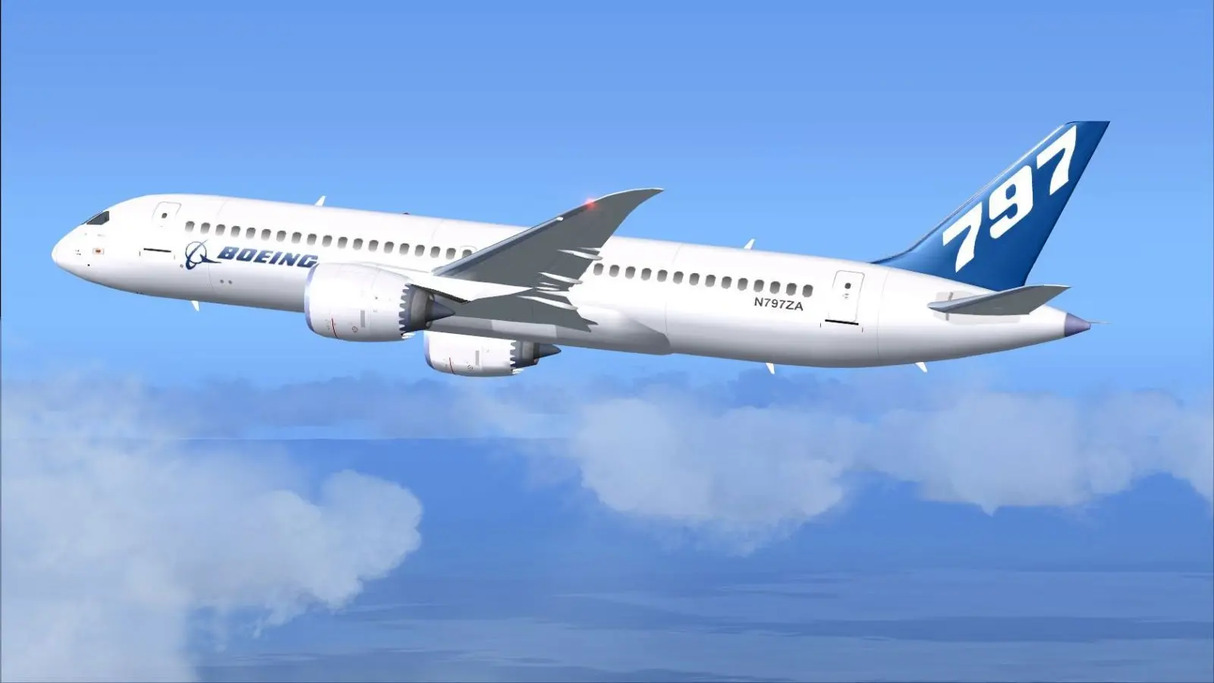
Is the Boeing 797 the future of aviation? The Boeing 797 is a highly anticipated aircraft designed to bridge the gap between the 737 and the 787 Dreamliner. Initially imagined as a blended wing body aircraft, this design was scrapped due to comfort and evacuation concerns. Now, Boeing aims to restart the project post-pandemic, promising a more efficient and comfortable flying experience. With two variants, the 797-6 and 797-7, it aims to replace the aging 757 and 767 models. Featuring advanced turbofan engines and composite materials, the 797 is set to compete with Airbus A321neo and A321XLR, offering superior fuel efficiency and reduced emissions.
Key Takeaways:
- The Boeing 797 is a proposed aircraft aiming to bridge the gap between the 737 and 787, offering improved efficiency and passenger comfort. However, its development has been paused due to the COVID-19 pandemic.
- Boeing's 797 promises advanced technology, environmental friendliness, and enhanced passenger comfort. Despite facing challenges, it has garnered positive market response and holds the potential to reshape the aviation industry in the future.
The Boeing 797: Bridging the Gap
The Boeing 797 is a highly anticipated aircraft designed to fill the gap between the Boeing 737 and the 787 Dreamliner. This aircraft aims to provide a more efficient and comfortable flying experience for both passengers and airlines. Here are some key facts about this exciting new aircraft.
- The Boeing 797 is a proposed commercial aircraft designed to replace the Boeing 757 and 767.
- Initially, it was conceptualized as a blended wing body (BWB) aircraft, seating at least 1,000 passengers.
- This design was later abandoned due to passenger comfort and evacuation concerns.
- As of now, the Boeing 797 is not a reality. Boeing has paused the project due to the COVID-19 pandemic.
- The primary purpose of the Boeing 797 is to provide airlines with a more efficient and cost-effective aircraft.
Technical Specifications and Design
The Boeing 797 promises to bring advanced technology and design elements to the aviation industry. Let's dive into some of the technical aspects.
- The Boeing 797 is expected to have two variants: the 797-6 and the 797-7.
- The 797-6 will have 225 seats and a range of 5,000 nautical miles.
- The 797-7 will have 275 seats and a range of 4,500 nautical miles.
- The aircraft is expected to be equipped with new turbofan engines featuring impressive bypass and overall pressure ratios.
- These engines will likely be quieter and more efficient than those on the Airbus A321neo.
Material and Environmental Impact
Boeing aims to make the 797 not only efficient but also environmentally friendly. Here are some facts about its materials and environmental performance.
- The Boeing 797 will feature a design that uses composite materials, similar to the 787 Dreamliner.
- This incorporation of carbon fiber will help reduce the aircraft's weight.
- The lighter weight allows for lower cabin pressure and higher humidity levels, improving passenger comfort.
- The main competitors of the Boeing 797 will be the Airbus A321neo and the Airbus A321XLR.
- Boeing aims to choose an engine system that offers better fuel efficiency than the Airbus A321XLR engines.
Passenger Comfort and Airline Benefits
Passenger comfort and airline benefits are crucial for the success of any new aircraft. The Boeing 797 aims to excel in both areas.
- The Boeing 797 is designed to improve environmental performance by reducing fuel use and emissions.
- It is expected to produce a 20% reduction in fuel use and a 50% smaller noise footprint compared to the NG aircraft.
- The 797 offers up to 14% lower airframe maintenance costs than the competition.
- Passengers will enjoy the Boeing Sky Interior, featuring modern sculpted sidewalls and LED lighting.
- Larger pivoting overhead storage bins will provide more space for carry-on luggage.
Challenges and Market Response
Every new aircraft faces challenges, and the Boeing 797 is no exception. However, the market response has been largely positive.
- CEO Dave Calhoun has stated that the 797 will help Boeing regain its position in the industry.
- Many airlines are excited about the 797, with Southwest CEO Bob Jordan expressing willingness to pay 50% more for it.
- United CEO Scott Kirby questioned whether the 797 is just a rebranded 737, highlighting the need for clear differentiation.
- The development of the Boeing 797 comes at a crucial time for Boeing, which has faced significant challenges with its 737 Max and Dreamliner programs.
- The aviation industry is currently dominated by Airbus, but Boeing aims to reclaim its position with the introduction of the 797.
Design Evolution and Future Plans
The design of the Boeing 797 has evolved over time, and Boeing has big plans for its future.
- The initial design concept of the Boeing 797 as a blended wing body aircraft was abandoned due to passenger comfort and evacuation concerns.
- The current design focuses on efficiency and comfort rather than radical new concepts.
- The development of the Boeing 797 is being conducted at Boeing's Phantom Works research facility in Long Beach, California.
- The X-48 was an unmanned experimental aircraft developed by Boeing in collaboration with NASA Langley Research Center.
- The Boeing 797 must comply with FAA regulations, which dictate that a full load of passengers must be able to evacuate an aircraft in 90 seconds.
Regulatory Compliance and Safety
Safety and regulatory compliance are paramount for any new aircraft. The Boeing 797 aims to meet and exceed these standards.
- The blended wing body design of the initial concept would have made evacuation problematic due to the theater-style seating arrangement.
- Even the current design needs to ensure adequate exit locations to meet FAA regulations.
- The proposed blueprint for the Boeing 797 lists only four actual exit locations, which would mean only two possible doors for evacuating 1,000 passengers.
- Boeing's Phantom Works division is also involved in developing military aircraft, which often require secrecy.
- The commercial Boeing 797 does not need secrecy, unlike military projects, which can be classified.
Future Outlook and Market Demand
The future of the Boeing 797 looks promising, with significant market demand and potential to reshape the aviation industry.
- Boeing plans to restart the 797 project once market conditions improve.
- The company is currently focused on the 777X program and other ongoing projects.
- The vertical stabilizer of the Boeing 797 is expected to be a different design from the 787, given its smaller size and reduced need for stabilization.
- The engines of the Boeing 797 are predicted to be relatively simple in design, without the iconic angular chevrons featured on the 787.
- The first real design of the Boeing 797 is likely to be seen in 5-7 years, given Boeing's current focus on other projects and the absence of significant demand for new airplanes during the pandemic.
Future of Aviation with Boeing 797
The Boeing 797 promises to be a game-changer in aviation. Designed to replace the aging 757 and 767, it aims to offer superior fuel efficiency, reduced emissions, and enhanced passenger comfort. With two variants, the 797-6 and 797-7, it will cater to different market needs, seating between 225 to 275 passengers. The use of composite materials and advanced engine technology will make it lighter, quieter, and more efficient. Though the project is currently on hold due to the pandemic, Boeing plans to restart it when market conditions improve. Airlines are already showing interest, eager for a more cost-effective and environmentally friendly option. The 797 could help Boeing regain its market share and reputation, making it a crucial part of their future plans. Keep an eye out; the skies might soon be graced by this innovative aircraft.
Frequently Asked Questions
Was this page helpful?
Our commitment to delivering trustworthy and engaging content is at the heart of what we do. Each fact on our site is contributed by real users like you, bringing a wealth of diverse insights and information. To ensure the highest standards of accuracy and reliability, our dedicated editors meticulously review each submission. This process guarantees that the facts we share are not only fascinating but also credible. Trust in our commitment to quality and authenticity as you explore and learn with us.


